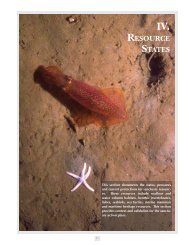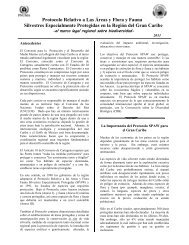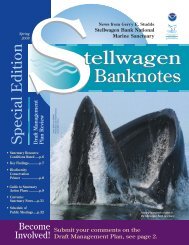sanctuary shipwreck paul palmer listed on national register of ...
sanctuary shipwreck paul palmer listed on national register of ...
sanctuary shipwreck paul palmer listed on national register of ...
You also want an ePaper? Increase the reach of your titles
YUMPU automatically turns print PDFs into web optimized ePapers that Google loves.
C<strong>on</strong>tact: Matthew Lawrence FOR IMMEDIATE RELEASE<br />
(781) 545-8026 ex 213 June 4, 2007<br />
Anne Smrcina<br />
(781) 545-8026 ex 204<br />
NOAA STELLWAGEN BANK SANCTUARY SHIPWRECK PAUL PALMER<br />
LISTED ON NATIONAL REGISTER OF HISTORIC PLACES<br />
The Nati<strong>on</strong>al Oceanic and Atmospheric Administrati<strong>on</strong> today announced that the wreck<br />
<strong>of</strong> the coal scho<strong>on</strong>er Paul Palmer, which rests <strong>on</strong> the seafloor within Stellwagen Bank Nati<strong>on</strong>al<br />
Marine Sanctuary, has been <str<strong>on</strong>g>listed</str<strong>on</strong>g> <strong>on</strong> the Nati<strong>on</strong>al Register <strong>of</strong> Historic Places, the nati<strong>on</strong>’s<br />
<strong>of</strong>ficial list <strong>of</strong> cultural resources worthy <strong>of</strong> preservati<strong>on</strong>.<br />
Paul Palmer’s historical, architectural and archaeological significance c<strong>on</strong>tributed to its<br />
listing. In compliance with President Bush's Preserve America Executive Order, NOAA is<br />
increasing efforts to inventory, preserve, and protect historic resources in the agency's care,<br />
from <str<strong>on</strong>g>shipwreck</str<strong>on</strong>g>s to historic buildings.<br />
“The scho<strong>on</strong>er’s involvement in the coal trade c<strong>on</strong>nected it to Americans throughout the<br />
East Coast,” said Stellwagen Bank <str<strong>on</strong>g>sanctuary</str<strong>on</strong>g> superintendent Craig MacD<strong>on</strong>ald. “Coal carried in<br />
scho<strong>on</strong>ers like the Paul Palmer powered the industrializati<strong>on</strong> <strong>of</strong> the northeastern states, <strong>on</strong>e <strong>of</strong><br />
the greatest ec<strong>on</strong>omic and social forces in American history.”<br />
Built in Waldoboro, Maine, the five-masted, 276-foot scho<strong>on</strong>er Paul Palmer was part <strong>of</strong><br />
William F. Palmer’s “Great White Fleet,” which at its peak c<strong>on</strong>sisted <strong>of</strong> 15 scho<strong>on</strong>ers that carried<br />
bulk cargos throughout the East Coast, Gulf <strong>of</strong> Mexico, and Caribbean. During its 12-year<br />
career, the scho<strong>on</strong>er Paul Palmer transported 280,000 t<strong>on</strong>s <strong>of</strong> coal, as well as phosphate,<br />
railroad ties, ice, and sugar.<br />
After unloading coal in Bangor, Paul Palmer departed Rockport, Maine, for Virginia <strong>on</strong><br />
Friday, June 13, 1913. Sailing south, the scho<strong>on</strong>er caught fire <strong>of</strong>f Cape Cod. Several vessels<br />
resp<strong>on</strong>ded to the stricken scho<strong>on</strong>er, but were unable to extinguish the fire. The scho<strong>on</strong>er’s crew<br />
aband<strong>on</strong>ed ship and was picked up by a waiting fishing boat. The Paul Palmer burned to its<br />
waterline and then sank. The Paul Palmer was the <strong>on</strong>ly five-masted East Coast scho<strong>on</strong>er to be<br />
lost to fire.<br />
The Paul Palmer was no stranger to fire. In 1907, the scho<strong>on</strong>er sustained light damage<br />
when it was nearly caught in a c<strong>on</strong>flagrati<strong>on</strong> that c<strong>on</strong>sumed Baltimore’s coal docks. The<br />
following year, a fire swept across East Bost<strong>on</strong>’s docks, catching the scho<strong>on</strong>er’s top rigging<br />
afire. Tugs pulled Paul Palmer away from its dock and put out the fire before flames engulfed<br />
the scho<strong>on</strong>er. The fire destroyed a quarter-mile stretch <strong>of</strong> the waterfr<strong>on</strong>t and caused $1.6 milli<strong>on</strong><br />
in property damage.<br />
Since NOAA’s discovery <strong>of</strong> the then-unknown <str<strong>on</strong>g>shipwreck</str<strong>on</strong>g> in 2000, the <str<strong>on</strong>g>sanctuary</str<strong>on</strong>g> has<br />
investigated the site with divers, remotely operated vehicles, and aut<strong>on</strong>omous underwater<br />
vehicles capturing detailed video and still imagery to document the vessel’s c<strong>on</strong>structi<strong>on</strong> and<br />
artifacts. This research led to the scho<strong>on</strong>er’s identificati<strong>on</strong> in 2002. The Paul Palmer’s partially<br />
buried remains lie <strong>on</strong> the flat, sandy seafloor atop Stellwagen Bank.
The scho<strong>on</strong>er’s locati<strong>on</strong> within Stellwagen Bank Nati<strong>on</strong>al Marine Sanctuary provides<br />
protecti<strong>on</strong> unavailable in other federal waters <strong>of</strong>f Massachusetts. Sanctuary regulati<strong>on</strong>s prohibit<br />
moving, removing, or injuring, or any attempt to move, remove, or injure any <str<strong>on</strong>g>sanctuary</str<strong>on</strong>g> historical<br />
resource, including artifacts and pieces from <str<strong>on</strong>g>shipwreck</str<strong>on</strong>g>s. Any<strong>on</strong>e violating this regulati<strong>on</strong> is<br />
subject to civil penalties.<br />
Stellwagen Bank Nati<strong>on</strong>al Marine Sanctuary encompasses 842 square miles <strong>of</strong> ocean,<br />
stretching between Cape Ann and Cape Cod <strong>of</strong>fshore <strong>of</strong> Massachusetts. Renowned for its<br />
scenic beauty and remarkable productivity, the <str<strong>on</strong>g>sanctuary</str<strong>on</strong>g> is renowned as a whale watching<br />
destinati<strong>on</strong> and supports a rich assortment <strong>of</strong> marine life, including marine mammals, seabirds,<br />
fishes, and marine invertebrates. The <str<strong>on</strong>g>sanctuary</str<strong>on</strong>g>’s positi<strong>on</strong> astride the historic shipping routes<br />
and fishing grounds for Massachusetts’ oldest ports also make it a repository for <str<strong>on</strong>g>shipwreck</str<strong>on</strong>g>s<br />
representing several hundred years <strong>of</strong> maritime transportati<strong>on</strong>.<br />
NOAA's Nati<strong>on</strong>al Marine Sanctuary Program seeks to increase the public awareness <strong>of</strong><br />
America's marine resources and maritime heritage by c<strong>on</strong>ducting scientific research, m<strong>on</strong>itoring,<br />
explorati<strong>on</strong> and educati<strong>on</strong>al programs. Today, the <str<strong>on</strong>g>sanctuary</str<strong>on</strong>g> program manages 13 nati<strong>on</strong>al<br />
marine sanctuaries and <strong>on</strong>e marine nati<strong>on</strong>al m<strong>on</strong>ument that together encompass more than<br />
150,000 square miles <strong>of</strong> America's ocean and Great Lakes natural and cultural resources.<br />
The Nati<strong>on</strong>al Oceanic and Atmospheric Administrati<strong>on</strong>, an agency <strong>of</strong> the U.S.<br />
Commerce Department, is celebrating 200 years <strong>of</strong> science and service to the nati<strong>on</strong>. From the<br />
establishment <strong>of</strong> the Survey <strong>of</strong> the Coast in 1807 by Thomas Jeffers<strong>on</strong> to the formati<strong>on</strong> <strong>of</strong> the<br />
Weather Bureau and the Commissi<strong>on</strong> <strong>of</strong> Fish and Fisheries in the 1870s, much <strong>of</strong> America's<br />
scientific heritage is rooted in NOAA.<br />
NOAA, an agency <strong>of</strong> the U.S. Commerce Department, is dedicated to enhancing<br />
ec<strong>on</strong>omic security and nati<strong>on</strong>al safety through the predicti<strong>on</strong> and research <strong>of</strong> weather and<br />
climate-related events and providing envir<strong>on</strong>mental stewardship <strong>of</strong> our nati<strong>on</strong>’s coastal and<br />
marine resources. Through the emerging Global Earth Observati<strong>on</strong> System <strong>of</strong> Systems<br />
(GEOSS), NOAA is working with our federal partners and 60 countries to develop a global Earth<br />
observati<strong>on</strong> network that is as integrated as the planet it observes, predicts and protects.<br />
- 30 -<br />
On the Web:<br />
NOAA: http://www.noaa.gov<br />
NOAA: http://www.oceanservice.noaa.gov<br />
NOAA Nati<strong>on</strong>al Marine Sanctuary Program: http://sanctuaries.noaa.gov<br />
NOAA Stellwagen Bank Nati<strong>on</strong>al Marine Sanctuary: http://stellwagen.noaa.gov<br />
NOAA Preserve America Initiative: http://preserveamerica.noaa.gov






